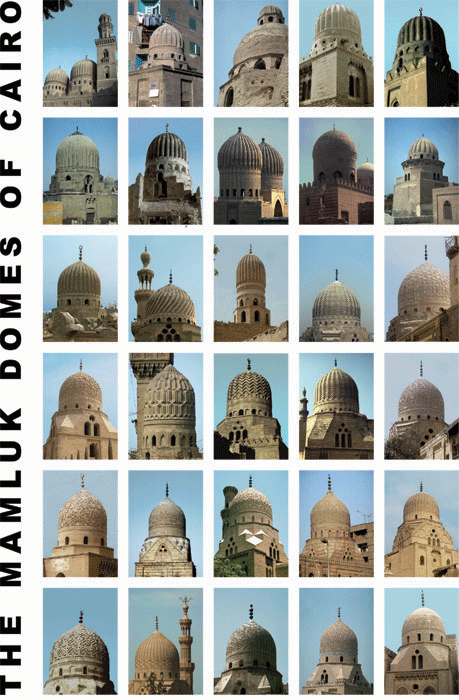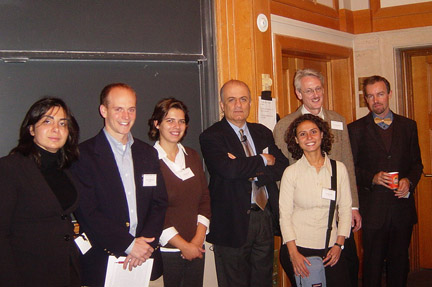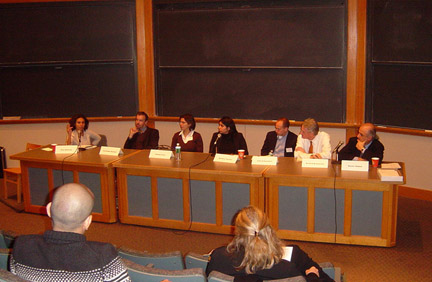Lectures, Conferences & Events» Conferences

A workshop sponsored by the Aga Khan Program for Islamic Architecture at MIT
This workshop will gather a group of scholars working on the Mamluk domes of Cairo alongside a number of MIT faculty and researchers interested in domical structures. Drawing upon recent archaeological discoveries and new digital techniques of representation, the participants will bring our knowledge of these outstanding domes up to date. The focus will be on their structural inventiveness, the shift in their construction material, and the incremental complexity in their decoration, as well as their architectural and urban significance.
SATURDAY, OCTOBER 29, 2005
10:00 to 1:00 & 2:00 to 5:00
MIT 6-120
Event is free and open to the public
ABSTRACTS
PICTURES OF THE EVENT
POSTER
PROGRAM
PROGRAM
10-10:15
Nasser Rabbat
Introductory Remarks
First Session
10:15 to 10:45
Richard Brotherton
Polyhedral Geometry, Syrian Stereotomy, Umbrella Honorifics,
and a Cairene Paradigm Shift in Stone Dome Construction Methodology
10:45 to 11:15
John Ochsendorf
New Methods for the Structural Analysis of Masonry Domes
11:15 to 11:30
Discussion
11:30 to 11:45
Coffee Break
Second Session
11:45 to 12:15
Barbara Cipriani
The Tradition of Dome Construction in Mamluk Cairo (1250-1517 A.D.)
12:15 to 12:45
Gemma Pinto
Domes and Muqarnas: a Virtual Reconstruction of Mamluk Architecture
12:45 to 1:00
Discussion
1:00 to 2:00
Lunch Break
Third Session
2:00 to 2:45
Christophe Bouleau
Materials and Building Techniques in
the Mamluk Mosques of Umm as-Sultan Sha’ban and of Khayer Bek
2:45 to 3:15
Dina Bakhoum
The Stone Domes of the Madrasa and Mosque of Umm al-Sultan Sha’ban:
Their Restoration and Conservation
3:15 to 3:30
Coffee Break
3:30 to 5:00
General discussion with the participation of MIT and Harvard scholars
ABSTRACTS
TOP OF THE PAGE
Dina Bakhoum
The Stone Domes of the Madrasa and Mosque of Umm al-Sultan Sha‘ban: Their Restoration and Conservation
The Aga Khan Cultural Services-Egypt under the Aga Khan Trust for Culture started in 2003 the restoration and conservation activities of the Mamluk madrasa and mosque of Khawand Baraka, known as Umm (mother of) al-Sultan Sha‘ban. This monumental complex includes two important and magnificent stone domed mausoleums that seen from below appear to be not only huge but also mysterious.
This presentation will explain in detail the challenging and enlightening process of the restoration interventions. It started by the erection of exterior and interior scaffolding allowing us to reach every decorative and non-decorative part of the dome. Technical tests were made to help us choose the appropriate conservation and restoration methods. The presentation will show how the cleaning and restoration interventions of each and every stone of the dome, covered by layers of dust accumulated over the decades, gives us a unique opportunity to better understand and relate to the architectural, technical, decorative, historic and previous restoration aspects of those “mysterious” domes.
Christophe Bouleau
Materials and building techniques in the Mamluk mosques of Umm as-Sultan Sha’ban and of Khayer Bek
he conservation projects of Umm as-Sultan Sha’ban mosque and of of Khayer Bek complex were initiated by the Aga Khan Trust for Culture and are under implementation since 2001 by the Trust’s local company in Egypt, Aga Khan Cultural Services-Egypt, under the supervision of the Egyptian Supreme Council of Antiquities.
Both monuments date back from the Mamluk dynasties and include several stone domes which have been or are currently subject to conservation.
Among other social and development objectives, those projects are aimed to study and document the condition of both Mamluk religious foundations: in this sense, a conservation project proves to be a unique and valuable opportunity to document the monument and to understand better its materials and building techniques. Surveys and studies on materials and history of construction are complemented by field experiments of contemporary additions calling for the revival of tradutional techniques.
Although exceptionnal in the field of conservation, the opportunity of reconstructions, as were the cases of both Umm as-Sultan Sha’ban and of Khayer Bek minarets in 2003, can be considered a full-scale test for historical hypothesis concerning building techniques.
This presentation intends to provide technical inputs from the field and is an attempt to bring more light to the process of production of Mamluk architecture in Cairo.
Richard Brotherton
Polyhedral Geometry, Syrian Stereotomy, Umbrella Honorifics, and a Cairene Paradigm Shift in Stone Dome Construction Methodology
Two dome representational schemas (décor-modes) are posited for the medieval Islamic world, neatly exemplified by the north and south domes of the Great Mosque of Isfahan: the princely umbrella-form of the south dome appropriate to its use as a maqsura, and the complex geometric division of the heavenly sphere in the north dome. Like Hagia Sophia the Isfahan domes deliver their message internally: the attenuated funerary domes of Mamluk Cairo, like St Peter’s Rome broadcast their’s (the architectural equivalent in the Islamic world of Wren’s combination of both in St Paul’s being found in Timurid Samarkand).
Now, unlike the lower cylindrical and upper conical parts (in the schema of W.R. Lethaby) which may be developed (flattened out), to inscribe plane geometric patterns with minimal distortion and proper continuity on the central truncated spherical portion of the typical Cairene funerary dome the net of a Platonic or Archimedean polyhedron would best have been used. We can demonstrate that such spherical geometrical knowledge was within the repertoire of thirteenth century Syrian stonemasons, a repertoire which also included the equally complex stereotomical technique of spherical stone voussoir cutting, itself a, non-indigenous to Egypt, prerequisite to the creation of the carved masonry domes of medieval Cairo. Thus, while the technique had been used earlier in Cairo to inscribe the geometric pattern on the semi-dome of the Mihmandar jami entrance portal the fact that it was not used for the domes of the Barsbay funerary complex suggests that the umbrella mode –with its triangular gores, or shawazik panels, which constitute what Christel Kessler calls an apex-seeking design– rather than the geometric décor mode was inherent in the conception of the attenuated Cairene funerary dome.
The hypothesis of the Umbrella dome (form and/or décor mode) as primarily a princely signifying device problematically cuts to the core of the issue of Islamicity of features in religious building types. The high princely signifying power and pervasive oriental honorific use of the umbrella qua textilic parasol which links the gold-embroidered yellow silk domical (qubba) umbrella (jitr, shatr <Indo-Persian chatr) of the Mamluk Sultans with Achaemenid royal protocol as carved on the Palace of Darius at Persepolis, via, among others, the Fatimid caliphal domical (qubba) umbrella (mizalla) of twelve panels (shawazik), and the black Abbasid caliphal umbrella (shamsiya), is outlined while noting the high correlation of umbrella-form domes with maqsuras and funerary structures. The latter signifying force being highlit by the account of the C12th usurpation of Saljuq sultanic power, titulature and customs, including umbrella usage, by Ala al-Din Husayn the Ghurid, such that the Ghazna burial place of his nephew Sultan Mu’izz al-Din Muhammad, was where his ceremonial umbrella (chatr) was kept until it was removed to be held over the Khwarazm Shah, Ala al-Din Muhammad ibn Takash, as part of the transfer of power to him. Thus, the correlation of the mamluk sultanic and amiral prestige and perogative of ceremonial umbrella usage with their funerary architectural forms, is identified.
It is the juxtaposition of the west dome, seemingly squat yet of exquisite smooth Syrian ashlar masonry work, added to the Cairene funerary complex of Salar and Sanjar al-Jawili with the soaring scalloped domes of these two amirs built of rendered brickwork, which highlights the Cairene construction paradigm shift necessary to achieve the latter nervous attenuated form using the inherently stable technique of the former.
Barbara Cipriani
The Tradition of Dome Construction in Mamluk Cairo (1250-1517A.D.)
This work investigates changes and similarities in the dome architectural features during the Mamluk rule in Cairo (1250-1517A.D. Through the comparisons of several dome examples and a detailed study of three specific cases, namely the ones topping the Mausolea of Umm Sultan Sha’ban (1369 A.D.), Farag Ibn Barquq (1389-1411 A.D.) and Amir Khayer Bek (1502 A.D.) this work reconstructs the structural behavior, the construction methods and the materials adopted in different moments of the Mamluk history.
This study is supported by different tools of investigation: a graphic method of structural analysis that establishes the limits of the load line for the condition of equilibrium in the domes; an extensive bibliography on Islamic domed building in Mamluk time;several restoration reports produced on Mamluk structures, and finally a laboratory analysis on samples of construction materials from the funerary complex of Amir Khayer Bek showing the inner properties of the Egyptian limestone and mortar.
The final aim is to interlace those results to have a better understanding of the technologies behind the construction of Mamluk domes and the reason why changes in material, geometry and dimensions occurred.
John Ochsendorf
New Methods for the Structural Analysis of Masonry Domes
Despite the rapid development of engineering analysis methods in the last century, the structural analysis of masonry domes is not completely understood. Recent research at MIT has developed new methods for the analysis of masonry domes which can provide greater understanding than was previously possible. Though there are still many unanswered questions, it is possible to gain insights into the structural behavior of masonry domes in general and Mamluk domes in particular. Specific points of discussion will include:
– structural comparison of stone versus brick;
– influence of dome geometry;
– influence of supporting structure;
– hypotheses about construction methods;
The goal of the talk is to share the current stage of research on masonry structures and to identify areas for future work.
Gemma Pinto
Domes and Muqarnas: a Virtual Reconstruction of Mamluk Architecture
The subject of the presentation is the virtual reconstruction of domed and transitional systems (muqarnas) of Mamluk mausoleums in Cairo which were built among 14th and 16th century. The interest field is limited to the analysis of mausoleums belonging to the monumental structures of north cemetery Al-Qarafah. In this area, the development of models which may become paradigmatic, allows to have a critical reading which tends to the identification of the building process of the architectural shape in order to understand its tectonic laws.
The goal of the study is to investigate the relationship between the form and its execution and work techniques by performing a stratigraphical reading of the systems that constitute the architecture in order to show its tectonic sequences, drawing up an abacus of its structural joints. This investigation is carried out by redesigning the horizontal sections of the construction framework with the aid of digital design. The use of computerized design techniques makes it possible to virtually disassemble individual elements in order to investigate the underlying laws that govern form, in two ways: in isolation, concentrating on the individual element, and globally, investigating the mutual relationships among the parts in relation to the whole.
The target is to create a digital model where it would be possible, thanks to a operation of emulation-simulation, re-build the building. The analysis insists on the systems that, for their theoretical-practical relation, between shape and building, could be considered as unique and representative of the building thought of the era when they were created: the transition system and the domed system.
The transitional system is the structural and formal link between the wall and the dome and it is constituted by muqarnas. It is aggregation of elements (pieces) according to a geometric grid that approximate, through regular polygons, the square (wall) to the circle (dome). The muqarnas are constituted by elements that are composed in overlapped rows producing complex compositions similar to “stalactites” in stone.
The domed system is constituted by a dome built by a pointed arch with an extrados surface richly decorated by geometric patterns. The stady of the bidimentional caracter of the geometric motive applied to the surface, suggest interesting questions related to the techniques of optic and geometric deformation used for proposing the pattern on the surface of the dome.
The mathematics and the geometry have had a fundamental role in the project and the building of the architectural form in Islamic area through the treatises of practical geometry. A study of ancient mathematical-geometry manuscripts from the 10th to the 15th centuries, in particular the essay written by Tabit Ibn Qurrà about the paraboloid bodies and the profiles of the domes and the essay of Al-Kashi about the profiles of the arches and the stereometry of domes and muqarnas, permits us to advance three fundamental questions on the reconstruction of the design-construction process used in the architectural work:
– What kind of knowledge (applied geometry) was necessary for builders?
– What were the structures built according to projects, designs and models generated by a
preliminary study?
– What were the technical procedures, the mathematical calculations or geometric schemes
used in architectural works?
The virtual model tend to give an answer to this kind of questions, because its structure is a geometric structure controlled by mathematical laws offering a valid technical support for the simulation of the formal and structural behaviour of the represented object.
PICTURES

LEFT TO RIGHT: Barbara Cipriani, John Ochsendorf, Gemma Pinto, Nasser Rabbat, Richard Brotherton, Christophe Bouleau FRONT: Dina Bakhoum

LEFT TO RIGHT: Dina Bakhoum, Christophe Bouleau, Gemma Pinto, Barbara Cipriani, John Ochsendorf, Richard Brotherton, Nasser Rabbat

LEFT TO RIGHT: Dina Bakhoum, Christophe Bouleau, Gemma Pinto, Barbara Cipriani, John Ochsendorf, Richard Brotherton, Nasser Rabbat